Archives: News
News and reviews
4th Friday 40 Leadership Series

You are invited!
GBA’s 4th Friday 40 Leadership Series
4th Friday 40 Leadership Series is a monthly webinar for GBA leaders at all levels to promote professional development, optimize influence, and facilitate achievement. In short, we want to help you to be a stronger, smarter, more successful leader.
Register in advance to secure your spot: HERE
Join our experts for a 40-minute webinar as they share valuable insights to help you be more confident, highly effective, and a more successful leader. Attend and earn one-half of a Professional Development Hour (PDH) for each webinar. Free to all GBA Members.
Our first three webinars will be presented by:
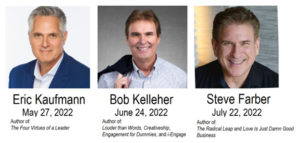
Put the 4th Friday Leadership on your calendar and invite your friends and colleagues to join you. After registering, you will receive a confirmation email containing information about joining the webinar.
Former ASFE President, Kenneth E. Darnell’s Passing
On April 27, 2022 Kenneth E. “Ken: Darnell, P.E. of Loudon, Tennessee passed away. 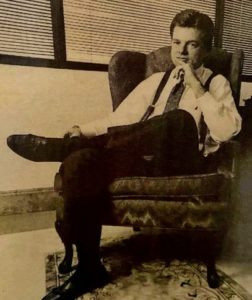 Ken was a significant contributor to our Association and served on the Board of Directors and as the President of ASFE in 1995-1996. He recognized the importance of mentorship.
Ken was a significant contributor to our Association and served on the Board of Directors and as the President of ASFE in 1995-1996. He recognized the importance of mentorship.
During his Presidency, he was instrumental in starting the Fundamentals of Professional Practice program which was for many years a rite of passage for rising stars in geoprofessional firms across North America.
Here is what a few of Ken’s friends and colleagues shared:
“Ken was an extremely clever guy, but just humble enough that you had to love him. Since I worked closely with Ken on the ASFE Board of Directors when he was the President, there is one particular impact that Ken had on our firm and many other ASFE firms at that time. That was back in the day that everyone was hung up on Quality and TQM. Ken had the ability to cut right to the chase. In this case, his reaction was to introduce us to W. Edwards Deming. The quality guru. Of any management consultant, Deming is the one person I think about when I’m really perplexed, i.e. “what would Deming have said?” because he spoke in such simple terms. Just like Ken did.” ~ Richard T. “Dick” Reynolds, PE, F. GBA, Past President (1996-1997)
“He was, all in all, a true professional. His ready smile and infectious laugh could obscure the fact that he was a master of geotechnical engineering, extraordinarily intelligent, and wise. As significant as his accomplishments might have been, however, he was quick to deflect praise and give credit to others whenever he believed it was their due . . . which was often.” ~ John Bachner, CEO Bachner Communications, Inc. and EVP of ASFE/GBA (1975-2015)
“I worked closely with Ken over the years, and he consulted with us as Terra’s first, Engineer Claim Consultant. He sorted out difficult engineering claim issues for us and simplified complex discussions. He was so smart- an intellectual- but he would never say so and would chafe at the moniker. I really liked Ken. He was such a wonderful person.” David L. Coduto, President, and CEO of Terra Insurance Company.
“Ken was a mentor to me for many years. He was a strong influence in my professional career and also a good friend. Countless times I benefited from having him as a sounding board and listening to his sagged, southern wisdom. His encouragement was one of the main reasons I became more deeply involved with GBA (ASFE). The values and behaviors that Ken exhibited were also reflected in GBA.
Our organization benefited from Ken’s leadership and involvement. His contributions were many. I feel very fortunate to have worked closely with him in the consulting business and in giving back to the profession. I’m a better person and professional for having known him.” Jay Martin, P.E., F.GBA GBA Past President (2010-2011)
More information about Ken Darnell can be found in his obituary: HERE
GBA and CalGeo Execute a Memorandum of Understanding

GBA and CalGeo Execute a Memorandum of Understanding
On April 7, 2022 the Geoprofessional Business Association (GBA) and the California Geotechnical Engineering Association (CalGeo) formalized an agreement to work together on common goals in an effort to advance engineering, science, continuing education, and public understanding of the geoprofession.
The memorandum of understanding includes in part:
“In recognition of our common and complementary purposes and  shared interests, the Geoprofessional Business Association (GBA) and the California Geotechnical Engineering Association (CalGeo) agree to formalize their relationship in advancing their mutual interests in confronting risk, optimizing performance, and promoting the value of the geoprofession, particularly on behalf of geotechnical and environmental engineers and engineering geologists through this Memorandum of Understanding (MOU).”
shared interests, the Geoprofessional Business Association (GBA) and the California Geotechnical Engineering Association (CalGeo) agree to formalize their relationship in advancing their mutual interests in confronting risk, optimizing performance, and promoting the value of the geoprofession, particularly on behalf of geotechnical and environmental engineers and engineering geologists through this Memorandum of Understanding (MOU).”
This effort was the result of several months of discussions between the leaders of both groups in support of a common understanding that when we work together, we can elevate the value of the geoprofessions.
A special thank you to the signatories, GBA President Thomas W. Blackburn, PE, GE (Blackburn Consulting), CalGeo President Mike Moscrop, P.E., G.E. (GMU Geotechnical, Inc.), CalGeo Treasurer Mike Cazeneuve, P.E., G.E., CEG (Taylor Group, Inc.), and CalGeo Executive Director, Nick Bundra.
Read GBA and CalGeo MOU: HERE
2022 Spring Conference Recordings Available
Those that attended GBA’s 2022 THINK BIG. ACT BIGGER Conference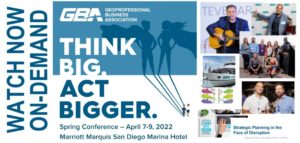 agreed that the keynote presentations were outstanding. Each was educational, entertaining, and inspiring. Now you can watch, listen to, and learn from these speakers too, on your own schedule.
agreed that the keynote presentations were outstanding. Each was educational, entertaining, and inspiring. Now you can watch, listen to, and learn from these speakers too, on your own schedule.
These videos are available for all GBA members on-demand at your convenience.
Watch Conference Recordings: HERE
SP22-01 Committees in Concert
An extension of the individual committee meetings, this gathering celebrates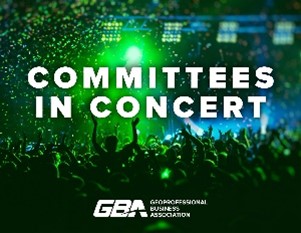 recent successes, share new goals for the coming year, and review opportunities for collaboration, all in an effort to best serve GBA and our members. Like an orchestra, GBA is an ensemble that produces the best results when the distinct groups work together. (40 minutes)
recent successes, share new goals for the coming year, and review opportunities for collaboration, all in an effort to best serve GBA and our members. Like an orchestra, GBA is an ensemble that produces the best results when the distinct groups work together. (40 minutes)
SP22-02 Extreme Leadership
In this chaotic and extreme age, business leaders must demonstrate an unprecedented level of  passion, determination, foresight, dedication, and fearlessness. In an encore performance for our THINK BIG, ACT BIGGER Conference, Steve Farber shows you how to use the LEAP framework – Love, Energy, Audacity and Proof to radically improve your organization and your life.
passion, determination, foresight, dedication, and fearlessness. In an encore performance for our THINK BIG, ACT BIGGER Conference, Steve Farber shows you how to use the LEAP framework – Love, Energy, Audacity and Proof to radically improve your organization and your life.
In this energetic and insightful program, discover how to:
o Inspire yourself and those you lead to achieve extraordinary results
o Earn your clients’ and employees’ love and loyalty
o Engage yourself and others.
Steve helps you understand how to build a corporate culture that attracts and retains the best talent, creates innovative products, and services, and yields radical results. (82 minutes)
SP22-03 Business Snapshot Summary
GBA’s Business Practices Committee launches a short survey each March of member firms on the state of the economy and assessment of the geoprofessional industry. During this brief presentation, Jason Stoops (G2 Consulting) shares the survey results so that you can assess how your firm and region is performing relative to others in the nation. (13 minutes)
of the economy and assessment of the geoprofessional industry. During this brief presentation, Jason Stoops (G2 Consulting) shares the survey results so that you can assess how your firm and region is performing relative to others in the nation. (13 minutes)
SP22-04 A Modest Investment with Outsized Gains: How Comprehensive PM Training Can Reduce Lost Profits
What happens when your A/E/C firm takes a holistic approach to Project Management training and codifies the most effective processes into your culture? For Gannett Fleming, it meant increasing positive variance and reducing negative variance to achieve significant measurable reductions every year in lost profits.
Join Arthur Hoffmann, P.E., D.GE (Gannett Fleming) as he shares this fascinating case study examining Gannett Fleming’s 10+ year project management improvement process. See how moving to an enterprise-wide embrace of PM standards and process improvement has achieved a profound and measurable impact on the bottom line – while simultaneously achieving measurable improvement in client satisfaction and other key performance indicators. (45 minutes)
SP22-05 CEOs Thinking and Acting Bigger 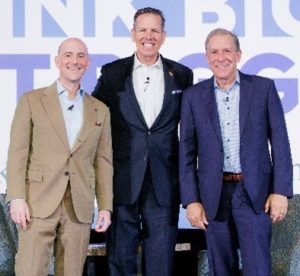
This panel session features leaders from two member firms discussing the importance of diverse voices to thinking and acting bigger. GBA Executive Director Joel Carson moderates the conversation with L. Joe Boyer, CEO of Atlas Technical Consultants and Louis Armstrong, CEO of Kleinfelder. They will highlight ways to impact recruiting, retention, growth, and profitability through strategic initiatives that promote an inclusive work force where everyone has an opportunity to contribute and succeed. (60 minutes)
SP22-06 Ownership Transition Success: Private Equity as an Option
In recent years private equity has become particularly interested in the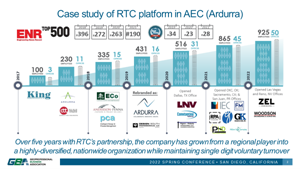 consulting engineering and science practices. This interest will only continue to grow due to the strong tailwinds around the space regarding the repair, modernization and construction of infrastructure and a renewed concern about the environment. Private equity firms are active acquirors across businesses of all sizes and can be an attractive option when it comes to ownership succession. During this session led by Christopher Lee (RTC Partners), learn why private equity has interest in consulting, engineering, and science practices. Understand how private equity can provide additional optionality in ownership succession. Explore staff growth opportunities through private equity capital infusion. (26minutes)
consulting engineering and science practices. This interest will only continue to grow due to the strong tailwinds around the space regarding the repair, modernization and construction of infrastructure and a renewed concern about the environment. Private equity firms are active acquirors across businesses of all sizes and can be an attractive option when it comes to ownership succession. During this session led by Christopher Lee (RTC Partners), learn why private equity has interest in consulting, engineering, and science practices. Understand how private equity can provide additional optionality in ownership succession. Explore staff growth opportunities through private equity capital infusion. (26minutes)
SP22-07 You Can’t Stop Change; So, You Have to Lead It!
They are calling it “The Great Resignation” – a phrase that has risen out of the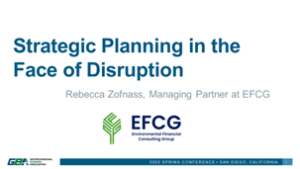 global pandemic with almost 50% of employees resigning and/or actively seeking new jobs. Employees are no longer human capital to be leveraged. They are key stakeholders in your business. They want their companies to have purpose, to have a soul, and they are not going to settle for anything less. The workplace and the workforce are shifting, and no amount of planning or stabilizing structure is going to stop it.
global pandemic with almost 50% of employees resigning and/or actively seeking new jobs. Employees are no longer human capital to be leveraged. They are key stakeholders in your business. They want their companies to have purpose, to have a soul, and they are not going to settle for anything less. The workplace and the workforce are shifting, and no amount of planning or stabilizing structure is going to stop it.
When you can’t stop change, it is still possible to lead it.
In this session led by Bonnie Hagemann (EDA, Inc.), attendees learn: the key ingredients to creating a compelling vision; how to engage employees around the vision; and how to shape a compelling culture that lasts. (77 minutes)
SP22-08 Technology and Automation Are Revolutionizing Geoprofessional Practice
Advances in technology and automation provide 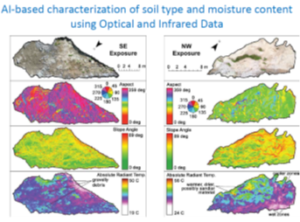 geoprofessional firms a chance to supplement and diversify their staff, improve performance, achieve efficiencies, and innovate. Geo-consulting firms can get more work done with fewer people. Many firms have opportunities for growth or market expansion but are limited by a shortage of geoprofessionals. New technologies and automation provide new options to mitigate that labor shortage. This presentation by Dimitrios Zekkos, Ph.D., P.E. (University of California at Berkeley) demonstrates how applications of technology and automation can achieve unprecedented efficiencies. Topics include Robots, UAVs, Artificial Intelligence, Satellites and use of Multi-Scale Frameworks to mitigate risk. (51 minutes)
geoprofessional firms a chance to supplement and diversify their staff, improve performance, achieve efficiencies, and innovate. Geo-consulting firms can get more work done with fewer people. Many firms have opportunities for growth or market expansion but are limited by a shortage of geoprofessionals. New technologies and automation provide new options to mitigate that labor shortage. This presentation by Dimitrios Zekkos, Ph.D., P.E. (University of California at Berkeley) demonstrates how applications of technology and automation can achieve unprecedented efficiencies. Topics include Robots, UAVs, Artificial Intelligence, Satellites and use of Multi-Scale Frameworks to mitigate risk. (51 minutes)
SP22-09 Partnership and Consortium for Growth and Success
Have you ever been told it is better to get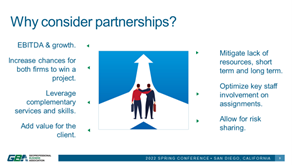 50% of something rather than nothing? Forging partnerships or consortiums with competitors to bid on larger projects and better execute the job has proven to be a winning approach for Martin LaRoche P.Eng (Kiewit) and François Santerre (Englobe). This presentation covers elements that can make a partnership or consortium with competitors a success. In addition, real situation examples are shared on some things not to do. Topics discussed include partnership / consortium opportunities and the criteria that make for a good fit; contractual agreements to adopt and why; terms between partner entities; scope split and selection of key resources; how to secure clients; project executive committee and its role; what happens if something goes wrong; and much more. (46 minutes)
50% of something rather than nothing? Forging partnerships or consortiums with competitors to bid on larger projects and better execute the job has proven to be a winning approach for Martin LaRoche P.Eng (Kiewit) and François Santerre (Englobe). This presentation covers elements that can make a partnership or consortium with competitors a success. In addition, real situation examples are shared on some things not to do. Topics discussed include partnership / consortium opportunities and the criteria that make for a good fit; contractual agreements to adopt and why; terms between partner entities; scope split and selection of key resources; how to secure clients; project executive committee and its role; what happens if something goes wrong; and much more. (46 minutes)
SP22-10 Strategic Planning in the Face of Disruption
A strategic plan provides a roadmap for a company’s leadership, employees, and clients to clarify where the firm is heading over the coming years. However, strategic plans are often left gathering dust on a shelf as firms deal with unexpected challenges (Pandemic!) or revert back to ‘business as usual’. Simultaneously, the A/E/C industry is facing several disruptive forces that have the potential to fundamentally change how we do business going forward, including technology, talent constraints, DE&I, and sustainability.
employees, and clients to clarify where the firm is heading over the coming years. However, strategic plans are often left gathering dust on a shelf as firms deal with unexpected challenges (Pandemic!) or revert back to ‘business as usual’. Simultaneously, the A/E/C industry is facing several disruptive forces that have the potential to fundamentally change how we do business going forward, including technology, talent constraints, DE&I, and sustainability.
This session with Rebecca Zofnass (Environmental Financial Consulting Group) reviews these trends and how they could impact short- and long-term strategy. Integration of these trends into strategic planning processes is also discussed, as well as ideas and best practices for how to successfully (and flexibly) build strategic plans in order to adapt to changing trends. (46 minutes)
SP22-11 President’s Annual Report
During this session, GBA President Tom Blackburn, P.E., G.E., F.ASCE, F.ACEC (Blackburn Consulting) provides the President’s Annual Report. (14 minutes)
These videos are available for all GBA members on-demand at your convenience.
Download the handouts
Watch Conference Recordings: HERE
GBA AWARDS RECIPIENTS
GBA AWARDS RECIPIENTS
GBA is a volunteer organization. Almost all the resources we produce for our members, 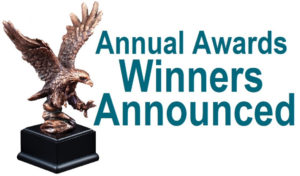 our contributions to the geoprofessional community, and our conferences are mostly driven by volunteer leaders.
our contributions to the geoprofessional community, and our conferences are mostly driven by volunteer leaders.
Each Spring, during our conference we recognize those that have contributed to GBA in a significant way. At our 2022 Spring Conference, awards were given to firms and individuals who exhibited extraordinary support and meritorious performance during our 2021-2022 fiscal year. Those recognized during the Annual Awards Ceremony were:
CERTIFICATES OF APPRECIATION
Each year we ask our Committees and Councils to provide us with the names of people that have contributed to our Association during the past year. Based on this list, we have more people contributing to GBA at a level higher than ever before.
Recipients of Certificates of Appreciation for 2021-2022
Victor Barchers, P.E.
Dave Cook, L.G., CPG 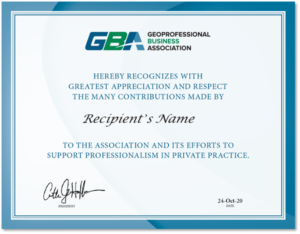
Blake Cotton, P.E., LEED AP
Pat Donovan, P.E.
Shawnna Erter, P.E., D.GE, F. ASCE
David Faulkner, P.E.
Kurt Fraese, L.G. F.GBA
Jeff Gebhard, P.E.
Daniel Gradishar, P.E.
Charlie Head, P.E., P.G., F.GBA
June Jewell, CPA
Jonathan Knudsen, P.E.
Michael Marasa, P.E.
Jay Martin, P.E., F.GBA
Mike McMeekin, P.E., ENV-SP
Bruce Miller, P.G.
Brad Nielsen, P.E.
Margaret Panatera, P.E.
Laura Register, P.E., LEED AP, F.GBA
Prashanth Vaddu, P.E.
Woody Vogt, P.E., D.GE, F.ASCE, F.ACI, F.ASTM, F.GBA
Travis Wambeke, P.E., P.G.
Steve Wendland, P.E., P.G., D.GE
AWARDS OF APPRECIATION
Special awards of appreciation were given to three volunteers who contributed to GBA 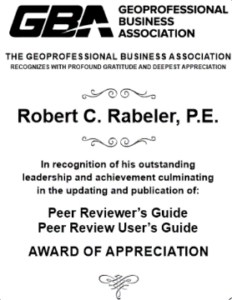 in extraordinary and unique ways during the year.
in extraordinary and unique ways during the year.
Those award winners were:
Robert C.Rabeler, P.E. (SME)
Bob Rabeler realized during the pandemic that something new and radical needed to be done to conduct Peer Reviews while we were working remotely and together with Terra Insurance Company found a way to deliver Peer Reviews remotely. He also volunteered to update two important documents for the Peer Review Process, the Peer Reviewer’s Guide and the Peer Review User’s Guide.
Grace Blackburn (Blackburn Consulting)
Gary DeJidas, P.E. (GAI Consultants)
Not long ago, our Peer Review Committee saw an opportunity 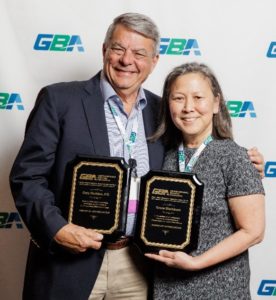 to create a new program where people with similar roles in member companies could come together in small groups to help each other, share best practices, and solve common problems. The same things we do throughout our association but in small groups for CEO’s, COO’s, CFO’s, and HR professionals. Imagine having a small group of like-minded people from different companies coming together regularly, with the help of a facilitator, to talk through common issues.
to create a new program where people with similar roles in member companies could come together in small groups to help each other, share best practices, and solve common problems. The same things we do throughout our association but in small groups for CEO’s, COO’s, CFO’s, and HR professionals. Imagine having a small group of like-minded people from different companies coming together regularly, with the help of a facilitator, to talk through common issues.
These two leaders saw how important one of our newest initiatives is and volunteered to facilitate Peer Groups. Both put time and energy into this effort and as a result, we have well-functioning Peer Groups and lots of happy members.
COMMITTEE LEADERSHIP 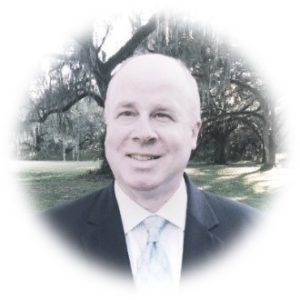
Daniel K. Schaefer, P.E. (Froehling & Robertson, Inc.)
Construction Materials and Testing Business Committee Chair 2017-2022
Steven K. Noble, P.E., PTOE (DOWL)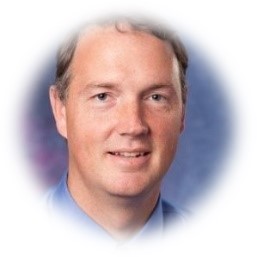
Business Practices Committee Chair 2020-2022
MEMBER FIRM ENGAGEMENT AWARDS
For several years, GBA has been tracking the engagement of member-firms through five measurements that we found to be most important indicators of the value members were receiving from membership.
Ultimately, engagement also indicates the value of membership to your employees which we feel is paramount to delivering our mission.
For the past four years, we presented awards to those firms who have the highest measured engagement in GBA during our fiscal year. We are proud to be able to recognize winners again this year. There are four award winners, one from each category based on firm size for Fiscal Year 2021-2022.
They are:
• Earth Engineering Consultants
• BSK Associates
• SME
• DOWL
Congratulations to all our FY 2021-2022 Engagement Award Winners
PROJECT AWARD OF EXCELLENCE
Leighton Consulting, Inc. – Gerald Desmond Bridge Replacement Project.  In 2020, the GBA Board of Directors identified an opportunity to celebrate greatness of our members as they use GBA’s best practices to manage risk and optimize performance on notable projects. This is the second year we presented the Project Award of Excellence to one of our member firms.
In 2020, the GBA Board of Directors identified an opportunity to celebrate greatness of our members as they use GBA’s best practices to manage risk and optimize performance on notable projects. This is the second year we presented the Project Award of Excellence to one of our member firms.
The second winner of GBA’s Project Award of Excellence is Leighton Consulting, Inc. Congratulations to Djan Chandra and the Leighton Consulting, Inc. team for their work on the Gerald Desmond Bridge Replacement project.
PRESIDENT’S AWARD
Saiid Behboodi, P.E., G.E. (PBS Engineering + Environment)
Each year, our current President selects one person to be recognized 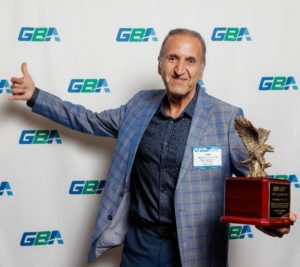 for the contributions they made to our Association during the year of his/her presidency.
for the contributions they made to our Association during the year of his/her presidency.
President, Tom Blackburn presented our 2021-2022 President’s Award to Saiid Behboodi in recognition of his many years of support and numerous contributions to GBA’s purpose and strategy through his enthusiastic ambassadorship, leadership and influence.
PRESIDENT’S GAVEL AWARD
Tom Blackburn, P.E., G.E., F.ASCE, F.ACEC (Blackburn Consulting)
During the awards ceremony, the Association recognized Mr. Blackburn for his years of service to the Board and for his leadership during his Presidency. Under Tom’s Presidency, GBA completed the 2024 Strategic Plan, increased communication with member firms, produced valuable 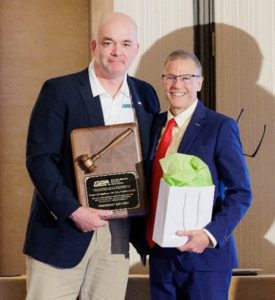 resources to benefit members, and increased engagement with alliance organizations in support of the Elevate Geoprofessional Value campaign.
resources to benefit members, and increased engagement with alliance organizations in support of the Elevate Geoprofessional Value campaign.
On behalf of the Board of Directors, all member firms, and Staff, we congratulate all the Award winners for Fiscal Year 2021-2022.
Leo Titus, Jr. Installed as President
Leo Titus, Jr., P.E. (ECS Group of Companies) is the new President of the Geoprofessional Business Association (GBA), a not-for-profit association of geoprofessional firms. Mr. Titus took office during ceremonies at GBA’s annual meeting held on April 8, 2022, in San Diego, California.
Mr. Titus will serve as GBA’s president 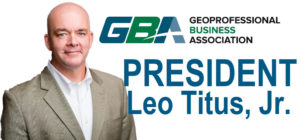 and chair the group’s board of directors.
and chair the group’s board of directors.
Other directors who will serve during GBA’s 2022-2023 fiscal year are:
• President-Elect: Christopher Matthew “Matt” Moler, P.E. (S&ME.)
• Secretary/Treasurer: Guy Marcozzi, P.E., LEED AP BD+C, F. ASCE (Verdantas)
• Victor R. Donald, P.E. (Terracon)
• Martin LaRoche, P. Eng., M.Sc. (Kiewit)
• Bradley M. Melocik, P.E., P.H. (DOWL)
• Teresa L. Peterson, P.E., C.M.E., LEED AP O+M, ENV SP (Gannett Fleming, Inc.)
• Dan Schaefer, P.E. (Froehling & Robertson)
• Steve Wendland, P.E., R.G., D.GE (GeoEngineers, Inc.)
During GBA’s 2022 Spring Conference, Mr. Titus thanked the Association Members for their confidence in his leadership and shared his plans to support GBA’s 2024 Strategic Plan, elevate the committee experience for volunteers, and improve engagement of members.
Environmental Justice: A Primer for Geoprofessionals
GBA Environmental Business Committee
Authored by Margaret Panatera, P.E. (GZA GeoEnvironmental)
Reviewed/edits by Daniel Gradishar, P.E. (Terracon) and Victor Barchers, PE (Kleinfelder)
1. What is Environmental Justice?
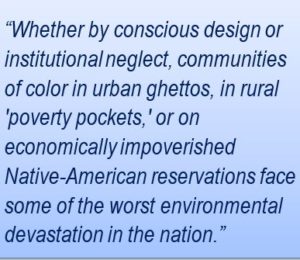 Environmental justice (EJ) involves the fair treatment and meaningful involvement of all people regardless of race, color, national origin, or income as it relates to development, implementation and enforcement of environmental laws, regulations, and policies. No group bears disproportionate share of negative environmental consequences. Groups and individuals have an opportunity to participate in decisions and voice community concerns as it relates to EJ.
Environmental justice (EJ) involves the fair treatment and meaningful involvement of all people regardless of race, color, national origin, or income as it relates to development, implementation and enforcement of environmental laws, regulations, and policies. No group bears disproportionate share of negative environmental consequences. Groups and individuals have an opportunity to participate in decisions and voice community concerns as it relates to EJ.
EJ impacts site locating, permitting, and conditions for new development or redevelopment.
2. What do Federal Regulatory Agencies Recommend?
Several Federal regulatory agencies and state 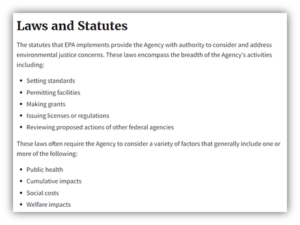 agencies recently made EJ a priority in future strategic planning. Specifically, Executive Order 12898 in 1994 started the EJ movement. EJ integration at the EPA has occurred with every regional and headquarter office having an EJ coordinator. The EJ coordinators have a suite of programs in specific areas of interest such as air quality, drinking water, hazardous waste sites, and lead.
agencies recently made EJ a priority in future strategic planning. Specifically, Executive Order 12898 in 1994 started the EJ movement. EJ integration at the EPA has occurred with every regional and headquarter office having an EJ coordinator. The EJ coordinators have a suite of programs in specific areas of interest such as air quality, drinking water, hazardous waste sites, and lead.
3. What are the Potential Business Opportunities for Geoprofessional Consulting Firms?
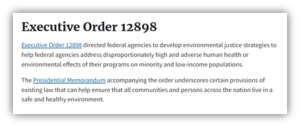 GBA firms provide assistance with permitting considerations during hearings, on submitted plans, and through various other outreach channels. With more focus on EJ, public outreach and community learning becomes a valuable input for regulatory agencies. Experience with managing EJ concerns in our projects can be a significant competitive advantage to GBA members
GBA firms provide assistance with permitting considerations during hearings, on submitted plans, and through various other outreach channels. With more focus on EJ, public outreach and community learning becomes a valuable input for regulatory agencies. Experience with managing EJ concerns in our projects can be a significant competitive advantage to GBA members
Learn More About Environmental Justice: HERE
Titus, Moler, Marcozzi Lead GBA’s 2022-2023 Board of Directors Slate
GBA Nominating Committee
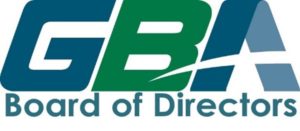
GBA’s Nominating Committee has announced its slate of officers and directors for the May 1, 2022-April 30, 2023 fiscal year.
GBA President-Elect and Board Chair-Elect, Leo Titus, Jr., P.E. (ECS, Ltd.) will become President and Chair of the GBA Board of Directors
Those nominated for the other two officer positions are, for President-Elect and Board Chair-Elect, Christopher Matthew “Matt” Moler, P.E. (S&ME, Inc.), and Guy Marcozzi, P.E., LEED AP BD+C, F.ASCE (Verdantas) for Secretary-Treasurer.
Those nominated to serve as Directors-at-Large are: Victor R. Donald, P.E. (Terracon) Martin LaRoche, P.Eng., M.Sc. (Kiewit Engineering); Bradley M. Melocik, P.E., P.H.(DOWL); Teresa L. Peterson, P.E., C.M.E., LEED AP O&M, ENV SP (Gannett Fleming); Daniel. K. Schaefer, P.E. (Froehling & Robertson, Inc.) and Steve Wendland, P.E., R.G, D.GE (GeoEngineers).
GBA’s Current Board of Directors
2021 Engagement Report
Recently, GBA created and delivered customized engagement reports to all members to help you evaluate the value of membership and identify ways to receive more value in the future.
It is important to us that you receive full value from your membership. 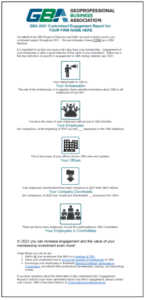 Engagement of your employees is often a good indicator of the value of your investment.
Engagement of your employees is often a good indicator of the value of your investment.
Below are a few key indicators of your firm’s engagement in GBA during calendar year 2021.
• Your Ambassador to GBA.
• Your Employees in GBA’s Database
• Your Offices in GBA’s Database
• Your Employee Downloads
• Your Employees Participating in Committees
The feedback from our members was outstanding!
“Kudos on a really great membership engagement report. I think that is a cool outreach to members and a helpful way to drive further engagement. Good stuff!”
“Very helpful.”
“Thank you very much for sharing our 2021 Customized Engagement Report. We greatly appreciate your efforts in sharing this information!”
“Great report! No other association does this! Love it!”
To review your customized engagement report, please check with your Ambassador to GBA or contact our staff.
Annual Project Excellence Award Applications are Open
GBA is excited to announce the 2022 Outstanding Project Award. With this prestigious award,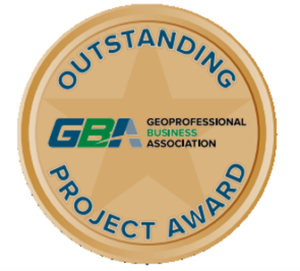 GBA will recognize some of the most outstanding projects by its members who live and demonstrate the vision of GBA to great accomplishment. Winners of this award will truly showcase their hard work and contributions to society in front of all of their peers, clients and other professionals from across North America.
GBA will recognize some of the most outstanding projects by its members who live and demonstrate the vision of GBA to great accomplishment. Winners of this award will truly showcase their hard work and contributions to society in front of all of their peers, clients and other professionals from across North America.
Winners will receive a plaque, will be recognized at GBA’s Annual Awards Ceremony in April 2022, and present their project at GBA’s 2022 Fall Conference.
Deadline for applications is January 31, 2022.
More Information HERE
A Revised ASTM Standard Practice for Phase I Environmental Site Assessments
By: W. Jerrold Samford, P.G., F.GBA
ASTM has revised the “Phase 1” standard practice, E1527. The revised standard should now be cited by consultants as E1527-21. While it has been submitted to  EPA for review, EPA has not issued a statement concurring that the revision meets the minimum performance requirements of the AAI process and consequently is not technically suitable for use in asserting the various “due diligence” defenses to CERCLA liability. EPA representatives were intimately involved in the revision process, and it is very unlikely that EPA will not concur. We don’t expect to see their official concurrence until sometime in the middle of 2022 at the earliest. Nothing in the revised standard reduces the level of effort, or eliminates elements of the process, compared to the previous version; consequently, a consultant complying with the requirements of the revised standard will have complied with the previous version as well. There should be no reason to avoid citing the revised standard even in the absence of formal concurrence by EPA. Additionally, because the federal “All Appropriate Inquiry” rule is a performance-based test, rather than a prescriptive procedure, EPAs concurrence states that using the ASTM standard is one method, but not the only method, of complying with AAI.
EPA for review, EPA has not issued a statement concurring that the revision meets the minimum performance requirements of the AAI process and consequently is not technically suitable for use in asserting the various “due diligence” defenses to CERCLA liability. EPA representatives were intimately involved in the revision process, and it is very unlikely that EPA will not concur. We don’t expect to see their official concurrence until sometime in the middle of 2022 at the earliest. Nothing in the revised standard reduces the level of effort, or eliminates elements of the process, compared to the previous version; consequently, a consultant complying with the requirements of the revised standard will have complied with the previous version as well. There should be no reason to avoid citing the revised standard even in the absence of formal concurrence by EPA. Additionally, because the federal “All Appropriate Inquiry” rule is a performance-based test, rather than a prescriptive procedure, EPAs concurrence states that using the ASTM standard is one method, but not the only method, of complying with AAI.
Changes made to the standard practice fall into the category of clarifications rather than substantive changes. ASTM has included examples of recognized environmental conditions (RECs, HRECs, and CRECs) that are designed to reduce perceived ambiguity in the definitions. The consultant is now also specifically required to provide not only his/her opinion of the impact of a particular situation, but also explain the logic behind the determination.
The standard has always contained the requirement that “The report shall describe all services performed in sufficient detail to permit another party to reconstruct the work performed. (Sec. 12.4).” The revision has taken this concept and embedded it within other sections of the standard, providing emphasis to the requirement. For example, Sec. 12.3 emphasizes that “A site plan showing the approximate location of features, activities, uses, and conditions …shall also be included.” This requirement, while previously unstated in the standard, was always implied by the Sec. 12.4 requirement, but too often omitted by consultants. Because there is now an explicit statement, we would expect to see better compliance.
Sections throughout the standard have been updated and clarified. For example, the list of government records has been updated to reflect the various changes in environmental databases that are available to be reviewed and changes in the names of the databases. Most of the consultants use commercial database search firms for their research. Those firms have always updated their lists as the lists evolve; consequently, this change has no real material impact on what is actually done.
Lists of historic resources have been explained in more detail while retaining the underlying requirement that research sufficient to determine the history of the Site to 1940 or first developed use is the fundamental requirement of the process.
Sec. 4.6 clarifies the viability time-frame for the Phase 1 report. Historically, the standard noted that a report completed within 180 days prior to the close of the transaction was presumed viable. EPA has previously indicated that the 180-day time period was to be measured from the completion of the critical components of the study, not from the date the report was issued. The logic behind that is clear. The revised standard now states clearly the procedure for determining the viability of a report.
Mr. Samford serves on the Environmental Business Committee and as the Chair of the Council of Fellows. He may be reached at jerry.samford@troutman.com
GBA Diversity, Equity, and Inclusion Series – Episode #3 – Allies in Diversity, Equity, and Inclusion
Summary
In this episode of the DEI series, we will be discussing allies in diversity, equity, and inclusions. Allies can be essential to drive systemic improvements to workplace policies, practices, and culture. But what does it mean to be an ally? How can allies impact the recruitment process? What effect does allyship have on the retention of employees? And what can we do to create more allies?
Our Guest
Charlie Head, PE, PG Founding Principal / Sanborn, Head & Associates, Inc.
Charlie is a co-founder of Sanborn Head. He serves as the Chair of the company’s board of directors and oversees the implementation of the firm’s strategic plan.
Charlie actively steers initiatives related to the expansion of the firm’s services and markets. Charlie remains active in Sanborn Head’s professional practice, with particular emphasis on environmental assessment and remediation, including due diligence for clients globally. Charlie received his bachelor’s degree in geology from St. Lawrence University, a bachelor’s degree in civil engineering from the University of New Hampshire, and a master’s degree in civil and groundwater engineering from Colorado State University. 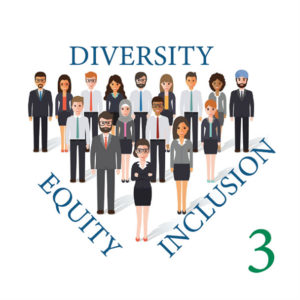
For Charlie, the real thrill of working at Sanborn Head is the creative problem solving and collaboration that fosters deep relationships—among staff and with clients. In his current role, Charlie enjoys focusing on the growth and sustainability of the company and helping to create opportunities for the next generation.
Charlie is a Professional Engineer in Arkansas, Georgia, Iowa, New Hampshire, Ohio, South Carolina, Tennessee, and Virginia; he is a Professional Geologist in New Hampshire.
Topics for discussion include:
• What does it mean to be an ally?
• Addressing the “leaky pipeline”.
• How DEI can affect the recruitment process.
• The effect an ally can have on the retention of employees.
• Recruiting more allies.
Lessons Learned:
• Understanding and evaluating our own biases.
• DEI initiatives should go hand in hand with the recruitment process.
• There’s no shame in making mistakes.
Calls-to-action:
• GEOSTRATA: The Pipeline to Diversity and Inclusion in the Geoprofessions
• Visit the GBA Website at https://www.geoprofessional.org for other training resources and reference materials and/or to become a member.
• Visit https://www.gbapodcast.com for future Podcast Episodes
• Contact us at info@geoprofessional.org with any podcast-related questions or comments
Subscribe
• Subscribe to the GBA Podcast https://www.gbapodcast.com/subscribe
This episode was produced by the following GBA Members:
• Veronica DeFreitas, PE (host) – Geotechnical Department Manager/Universal Engineering Sciences
• Ryan White, PE, GE – Principal Geotechnical Engineer/PBS Engineering and Environmental Inc.
Listen to Podcast: HERE
Important Changes to IPC that All Geoprofessionals Should Know About
GBA Geotechnical Business Committee
New language in the 2024 International Plumbing Code (IPC) will explicitly 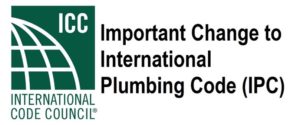 mandate how under-slab plumbing is to be protected from expansive soil, reducing professional liability risk for geotechnical engineers. Rather than wait for local building codes to adopt the 2024 IPC (which will take several years), the Geoprofessional Business Association (GBA) recommends that member-firms address this issue now for project sites with expansive soils and start referencing the new 2024 IPC language now in their geotechnical reports. Details of the code change and GBA’s recommendations are provided below.
mandate how under-slab plumbing is to be protected from expansive soil, reducing professional liability risk for geotechnical engineers. Rather than wait for local building codes to adopt the 2024 IPC (which will take several years), the Geoprofessional Business Association (GBA) recommends that member-firms address this issue now for project sites with expansive soils and start referencing the new 2024 IPC language now in their geotechnical reports. Details of the code change and GBA’s recommendations are provided below.
Background for Code Change
Geotechnical engineers occasionally get tangled up in litigation related to leaky plumbing. While plumbing design and construction are not within the geotechnical scope of work, when expansive soils are present at a site 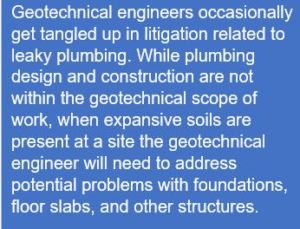 the geotechnical engineer will need to address potential problems with foundations, floor slabs, and other structures. Water from leaking plumbing can cause expansive clay soils to swell much more than anticipated.
the geotechnical engineer will need to address potential problems with foundations, floor slabs, and other structures. Water from leaking plumbing can cause expansive clay soils to swell much more than anticipated.
That increased swelling can compound the issue by making leaks even worse, potentially leading to failure of the plumbing and/or structural damage to a building. This damage can be greater, and more expensive to repair, when the floor slab is isolated from expansive soil but the plumbing is not. When these plumbing failures occur, the resulting litigation is often unfairly targeted at the geotechnical engineer of record by association due to the role of expansive soils.
IPC Code Change
To reduce the risk of plumbing failures and resulting litigation, changes in the next edition of the IPC have been made that prohibit the use of plumbing that is directly or indirectly in contact with soil in the active zone below floor slabs that are isolated from expansive soil (e.g., slabs that are over a crawlspace or voidforms). In these cases, the plumbing below the structure must be entirely isolated from contact with the soil. Prior to this code change, plumbing that is only partially isolated (i.e., proprietary products are used to create indirect contact between the plumbing and the expansive soil) has been allowed by building officials. However, there are concerns about those products failing because they do not actually isolate the plumbing from expansive soil movement. The full text of the new code requirements is provided below.
These improvements to the IPC were proposed by the Structural Engineers Association of Texas (SEAoT). SEAoT also submitted to the IPC a 14-page rationale statement for the change which was based on a review of the state of the art, recent litigation, a publication from the Foundation Performance Association, and various products on the market. SEAoT’s proposal was supported by GBA, the American Institute of Architects, the American Council of Engineering Companies – Texas, and several individual engineers from various design disciplines. A representative of GBA testified during the International Code Council’s hearings on these changes earlier this year. GBA’s tehttps://www.aia.org/stimony was provided by Steve Wendland, PE, PG, DGE, a member of the GBA Board of Directors, who summarized the litigation experiences of GBA member firms that had dealt with this problem.
Reduce Your Risk – Take Action Now
New editions of codes are typically not put in force by local governments  until a few years after their publication, but GBA member firms can act now to reduce their risk as the standard of care changes. Rather than waiting years for these new plumbing code provisions to be enacted by the local government, GBA recommends that member firms act now for project sites with expansive soils. Taking this action now will also be beneficial for projects where the Uniform Plumbing Code (UPC) is in force; the UPC will not be making similar changes. For geotechnical reports on projects with expansive soils where the floor slab will be above a crawlspace or void forms, GBA recommends that the reports include recommendations that are consistent with this new section of the 2024 IPC, regardless of whether the IPC or the UPC is locally adopted. Specifically, the following (or similar) text could be used in a geotechnical report:
until a few years after their publication, but GBA member firms can act now to reduce their risk as the standard of care changes. Rather than waiting years for these new plumbing code provisions to be enacted by the local government, GBA recommends that member firms act now for project sites with expansive soils. Taking this action now will also be beneficial for projects where the Uniform Plumbing Code (UPC) is in force; the UPC will not be making similar changes. For geotechnical reports on projects with expansive soils where the floor slab will be above a crawlspace or void forms, GBA recommends that the reports include recommendations that are consistent with this new section of the 2024 IPC, regardless of whether the IPC or the UPC is locally adopted. Specifically, the following (or similar) text could be used in a geotechnical report:
• The expansive soils at this site will undergo shrink and swell with changes in moisture content. This soil movement can damage plumbing below the structure, especially where it connects to or penetrates the structure. Damaged plumbing will leak, causing significantly more swelling of the soils, leading to possible failures of the plumbing or structural damage to the building. The project mechanical engineer should account for this concern in their designs.
• Where slabs are isolated from expansive soils by an under-floor voidspace, such as with a crawlspace or a space created by voidforms, under-slab plumbing should be suspended so that plumbing, hangers, and supports are isolated from the expansive soil by a voidspace. The void space should be a minimum of [insert dimension] inches vertically clear above the subgrade and a minimum of [insert dimension] inches horizontally clear between the subgrade and any plumbing, hangers, or supports. To protect and maintain the voidspace, soil below it should be sloped or benched on a minimum of [insert number] units horizontally for every 1 unit vertically, or structurally retained in accordance with an approved design methodology that accounts for lateral expansion of expansive soil.
• It should not be permitted for the plumbing, hangers, and supports below the slab or below the framing to be in contact with soil or any assemblage of materials that is in contact with soil within the active zone. As a clarifying exception to this recommendation, it is acceptable for plumbing to be suspended by a deep foundation system. These recommendations for isolation of plumbing can be met by installing anchors and plumbing within a crawlspace after an isolated slab is installed. It should not be permitted for a slab and plumbing to be lifted off the subgrade as an assembly to create the voidspace unless the under-floor space is a crawlspace with access to allow inspection of plumbing after lifting. At each location where a plumbing line transitions to a buried condition beyond the perimeter of the foundation, an adequately flexible expansion joint should be provided in the plumbing system to accommodate the effects of expansive soil swelling and shrinking. The flexible expansion joint should also be isolated from soil and accessible for maintenance. These recommendations for isolation of plumbing do not apply to the portions of a plumbing system that provide drainage of an under-floor space.
• Several proprietary or patented systems are available on the market which are intended to isolate plumbing from expansive soil subgrades. However, many of these systems do not meet these recommendations. The project mechanical engineer should only use plumbing isolation systems on this project that are compliant with these recommendations.
Here is the final text of the new section that will be added to the 2024 IPC. The code changes are published on the International Code Council (ICC) website at https://www.iccsafe.org/products-and-services/i-codes/code-development-process/2021-2022-group-a/. Please note that the section numbers that are shown below may change before final publication:
305.8 Expansive Soil. Where expansive soil is identified under buildings in accordance with Section 1803.5.3 of the International Building Code, but not removed in accordance with Section 1808.6.3 of the International Building Code, plumbing shall be protected in accordance with Section 305.8.1 or 305.8.2.
305.8.1 Non-Isolated Foundations. Under foundations with slabs that are structurally supported by a subgrade, it shall be permitted for plumbing to be buried.
305.8.2 Isolated Foundations. Under foundations with a slab or framing that structurally spans over an under-floor space which isolates the slab or framing from the effects of expansive soil swelling and shrinking in accordance with Section 1808.6.1 of the International Building Code, the plumbing shall be suspended so that plumbing, hangers and supports are isolated, by a voidspace, from the effects of expansive soil swelling and shrinking.
Exception: It shall be permitted for plumbing to be buried if the plumbing provides drainage of an under-floor space.
To protect the voidspace, soil shall be sloped, benched or retained in accordance with an approved design methodology.
It shall not be permitted for the plumbing, hangers and supports below the slab or below the framing to be in contact with soil or any assemblage of materials that is in contact with soil within the active zone. It shall not be permitted for a slab and plumbing to be lifted as an assembly to create the voidspace unless the under-floor space is a crawlspace with access to allow inspection of plumbing after lifting.
Exception: It shall be permitted for the piping, fittings, hangers, and supports below the slab or below the framing to be
in contact with structural elements of the foundation that are designed to resist the effects of expansive soil swelling
and shrinking in accordance with Section 1808.6.1 of the International Building Code.
Organic materials subject to decay shall not be used for hangers, supports and soil retention systems. Materials subject to corrosion shall not be used for hangers, supports and soil retention systems unless protected in an approved manner.
Where plumbing transitions to a buried condition beyond the perimeter of the foundation, an adequately flexible expansion joint shall be provided in the plumbing system to accommodate the effects of expansive soil swelling and shrinking.
Summary
Expansive clay soils can be even more challenging when mixed with leaky plumbing. Such a failure and the resulting litigation was documented in GBA Case History 108 (podcast here). Changes that will be made to the 2024 IPC will reduce the risks caused by this situation. Until that new code is in force, geotechnical engineers should consider adding guidance on the topic, as summarized above, to their geotechnical reports.
Notice of Changes: Future GBA Conference Schedule
Forward
For more than 50-years, GBA has delivered two conferences annually, one in the Fall and one in the Spring. This will not change because GBA conferences provide timely and valuable information that our members use to manage risk and optimize business performance and our conferences promote networking to enhance collaboration and lessons learned.
Background
During the COVID pandemic, GBA held three Conferences and one Winter Leadership Summit using virtual platforms. This was a  “silver lining” for GBA and our member firms as the virtual environment delivered high-value content deep into our member firms. In fact, the attendance of GBA Conferences during the pandemic far exceeded our expectations with more than twice the number of people attending virtually as normally attend a GBA conference in person.
“silver lining” for GBA and our member firms as the virtual environment delivered high-value content deep into our member firms. In fact, the attendance of GBA Conferences during the pandemic far exceeded our expectations with more than twice the number of people attending virtually as normally attend a GBA conference in person.
GBA’s Board of Directors is continuously looking for innovative ways to provide value to our members in support of our purpose and strategy, and one way is to build on the success of virtual conferences.
A New Direction
Building on the successes of the virtual platforms and in support of GBA’s purpose and strategy, the Board of Directors has chosen to hold the 2022 Spring and 2023 Spring Conferences as hybrid events, which will include both in-person and virtual attendance options on our normal Friday/Saturday schedule.
Additionally, the Board decided the 2022 Fall Conference will be delivered entirely as a virtual event, with the goal of delivering high-value presentations, collaboration opportunities, and networking events to a larger audience of GBA members and avoiding travel and a weekend commitment by attendees.
All involved in these decisions recognize this is not how we have normally held conferences, and the new format may be difficult for some. This will be an opportunity to try a new approach that we hope will benefit more employees of member-firms, have a greater impact on your risk management and loss prevention, all while elevating our profession.
Looking to the Future
GBA will evaluate the effectiveness of the virtual 2022 Fall Conference before making decisions about future Fall events.
Please Join Us:
Please plan now to join your geoprofessional associates at our future conferences:
GBA 2022 Spring Conference
April 7-9, 2022*
Marriott Marquis, San Diego Marina Hotel
San Diego, California
A Hybrid Event
GBA 2022 Fall Conference
October 25-27, 2022**
A Virtual Event
GBA 2023 Spring Conference
April 20-22, 2023
Sawgrass Marriott Golf Resort and Spa
Ponte Vedra Beach, Florida
A Hybrid Event
* registration (both live and virtual) will be available January 24, 2022
** tentative conference dates to be confirmed by January 1, 2022
NEW! Best Practices: Software Validation
Surveys indicate most GBA Member-Firms do not have a formal process for 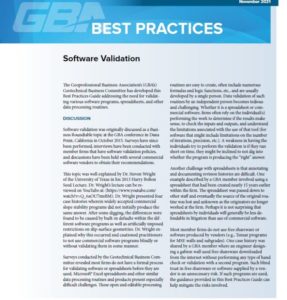 validating software or spreadsheets before they are used. This Best Practices document reviews the risks of using commercial software and spreadsheets blindly or without validation which may lead to inaccurate results and exposure to loss and litigation. It also provides recommended practices to manage risk by increasing accuracy of spreadsheets and software that you can start implementing now.
validating software or spreadsheets before they are used. This Best Practices document reviews the risks of using commercial software and spreadsheets blindly or without validation which may lead to inaccurate results and exposure to loss and litigation. It also provides recommended practices to manage risk by increasing accuracy of spreadsheets and software that you can start implementing now.
Read More: HERE